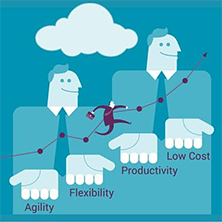Whether a business builds out its own cloud or buys cloud services from someone else, it needs to be sure that the end results are optimized. Cloud solutions in the market today are technology-centric and do not address issues of governance and process integration effectively. An effective solution is the one where technology and governance work in tandem. Lets consider a sample scenario to understand how enterprises can apply the ITSM framework and improve their readiness for cloud adoption.
Take the case of a CIO of a global travel firm, who manages the IT demands of rapidly growing business in diverse geographies with an approximate global IT team size of 250 members. This firm has four key business units Flights, Hotel, B2B and Holiday Packages. In face of eroding profitability and intense competition, there is relentless pressure on the CIO to deliver more with less. With the advent of cloud computing, CIO now wants to leverage cloud-based solutions to satisfy ever-increasing business demands without incurring a huge cost.
On analyzing cloud services options, the CIO realizes that cloud computing fundamentally alters the way services are sourced and delivered. She then sets up a cross-functional project team to lead the effort and ensure successful transition to the cloud.
The organization has already adopted ITIL couple of years back; since the cloud migration strategy is currently under way, the instituted project team works on priority to scale the current ITIL processes to cloud services. Knowing that service transition is all about building and deploying services, the project team first defines and then designs the way services will be provisioned through cloud. Service portfolio is augmented to include: services that will be provisioned through cloud; the level of investment that is being made in these services; and how they are being sourced, bundled, and providing value to the business. Relevant service-based roles are accordingly created.
Based on ITIL 2011 framework, the CIO and her team makes vendor management a focus area. She directs the project team to re-visit the existing vendor management processes and policies since cloud computing requires a renewed effort in supplier management processes. They also start defining the harmonization of the involved tools. As a part of cloud migration strategy, the project team defines Business Relationship Management (BRM) and drives One team, one vision culture that is built on cross functional collaboration.
The CIO and her team prepare a short write-up on the activities that will be undertaken and present it to business:
- Application of Service lifecycle approach of ITSM for cloud: The project team prioritizes the service lifecycle areas for adoption. The prioritized service areas include Business continuity management, BRM (business relationship management), SLM (service level management), change, and configuration, security, capacity and availability management practices.
- Creation of an integrated actionable service catalog with request management functionality that defines IT services. CIO explains to business heads that tracking of service requests will help the IT teams to measure service performance. This will also help with the understanding of frequency of service requests, demand management, data operations, associated risks, acceptable and desirable service levels, future scalability and availability and performance requirements, information security, data integrity checking services, etc.
- Planning for Service Transition to manage cloud transitions in a seamless and efficient manner. Team understands that vendor cloud is a shared responsibility environment and as such having an inclusive, well-structured and detailed transition plan and support process are critical for success. The CIO presents the detailed plan to business heads.
- Institution of agile and scalable governance, which focuses on vendor management integration with the identified prioritized service management service lifecycle areas.
The implementation is rolled out in two steps. First, the service owners design a few use cases and conduct a dry run. Based on the outcomes, they refine and align the processes. Second, they adopt a “self-learning” approach. They gather in groups to learn and then adopt these prioritized practices from the ITIL 2011 guidelines.
As a result of this prioritized process capability building, the transition to the cloud takes place smoothly and successfully within the program schedule. Since their requests are processed within hours, rather than weeks and months; business unit teams too are satisfied.
Key Learnings
An organizations ability to leverage cloud options depends on:
- Integration of enterprise cloud with its overall service management capability.
- Using/Extending/Applying service life cycle approach to cloud in relevant service areas like demand management, business continuity, information security and vendor management service.
- Dismantling silo-based organization structures e.g. technical silos (erver admin team, network admin team, data center teams, etc.)
- Instituting a unified governance framework that encompasses both cloud as well as on-premise business applications.
- Creating one team culture.
- Group learning programs: The team found that group learning, where various teams gathered together to do a collective learning of the defined solution brought better understanding and clarity than individual self-learning and formal training and certifications programs.
In order to provide effective IT services to business, some form of integrated standard approaches or governance models need to be developed that are applicable to both cloud and on-premise business applications. Existing cloud technology vendors do not cater to this need, and as such there exists a lacuna. ITSM 2011 can therefore be leveraged to develop strategy for cloud readiness and migration.
Cloud computing does not alter the business objectives of an enterprise rather it provides new possibilities to reach those objectives. For an organizations success with the cloud, effective governance and robust, integrated ITSM practices — covering cloud and on premise applications is imperative.
Kanchan is a former Happiest Mind and this content was created and published during her tenure.






